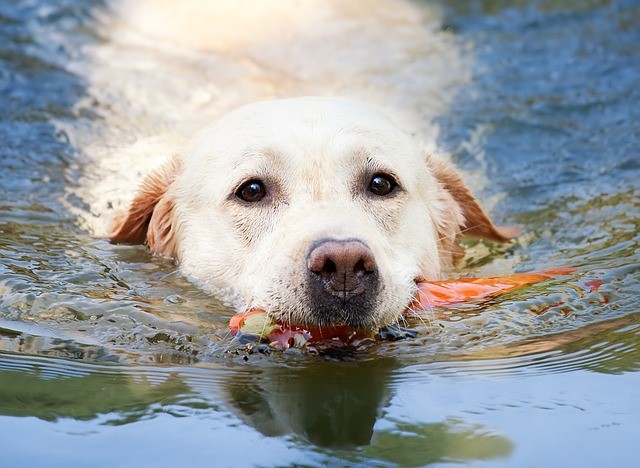Le nombre d’animaux
enregistrés augmente en permanence
Publié 15 juil. 2021

High temperatures cause a great deal of discomfort for pets. Your dog may feel sleepy and less eager to play in sweltering heat. Many dog owners consider this to be completely normal and not a cause for concern. But it is important to remember that dogs can in fact experience heat stroke, which is potentially dangerous! Learn the symptoms of heat stroke in dogs and how to prevent it!
Dogs are a lot worse at coping with high temperatures than humans, and heat stroke can progress very rapidly in a dog! This is because, unlike humans, our four-legged friends do not have sweat glands across their whole bodies, but only under the pads of their paws, which is why sweating can only get them so far. Dogs regulate temperature by panting, which may prove insufficient in high temperatures, especially in high humidity conditions and with no access to shade or fresh water to drink. When a dog’s body temperature rises to 40.5–43oC, it means that the dog is experiencing heat stroke.
Which dogs are especially prone to overheating?
Some dog breeds are more vulnerable than others. Particularly at-risk are the brachycephalic breeds, so those with shortened snouts – their thermal regulation mechanism is not as effective due to the structure of their muzzles.
Moreover, heat stroke symptoms are more frequent in animals which are:
● obese,
● suffering from respiratory tract disorders,
● suffering from vascular system disorders,
● suffering from nervous system disorders,
● dark-coloured.

Initial heat stroke symptoms are similar to those of fatigue and can easily be overlooked. The following symptoms can be observed during heat stroke:
● heavy breathing and panting;
● general weakness and inactivity;
● thick, viscous drool;
● mucous membrane dryness;
● trembling;
● disorientation;
● impaired vision;
● increased heart rate;
● vomiting;
● diarrhoea (often with blood).
Also frequent are nervous system-related symptoms such as numbness, involuntary shivers and confusion. The dog may wander off in search of water and shelter from the sun, which is why it is so important that your pet is chipped and registered in an animal database. This will make it easier to find it should it ever go missing.
Effects of heat stroke
Unfortunately heat stroke can have tragic consequences for a dog. If you fail to help your pet, it can fall unconscious and suffer organ failure, which may lead to chronic health issues, and unless immediate help is administered, the animal may die.
What should you do when your dog is exhibiting heat stroke symptoms? In the case of heat stroke, first aid mostly revolves around lowering the body temperature of your dog. This must be done quickly, but not abruptly, or the animal may go into shock.What should you do?
1. Move your dog to a safe, cool and ventilated location in the shade.
2. Give your dog fresh, room-temperature water to drink. Do not immediately give your dog cold water or ice cubes.
3. If your dog refuses to drink, wash any drool off its snout.
4. Cool off your dog by soaking its hair or applying cold compresses around the animal’s neck, tail and paws.
5. Watch your dog closely, making sure that its tongue is sticking out and that the animal can breathe without any trouble.
6. Check your dog’s temperature – it should drop to between 39.4 and 40 oC.
7. Contact your veterinarian! Even if your dog seems back to normal, it is possible that some organ damage has occurred, and the animal may still be dehydrated. Contact your veterinarian and take your dog for a visit – treatment may still be necessary after the heat stroke.
Remember these rules to quickly administer help!

As the temperature rises, you need to provide your dog with the right conditions for playing, walking and resting to prevent heat stroke. How do you prevent heat stroke during a heat wave?
First and foremost, avoid physical activity when the air temperature rises above 25oC. Walk your dog at dawn and late in the evening, and only leave the house during the day for short periods of time so that your dog can relieve itself. Your walk destinations should be forests or lakes, and instead of running across open spaces. Have your dog fetch its toy from the water.
The place your dog spends time in during the day should offer shade, and your dog should always have access to fresh water. Cooling mats and frozen snacks can also help.
It is important to remember that heat stroke is not the only hazard caused by high temperatures. How do you avoid skin and pad burns? Hairless breed owners should use special sunscreen to protect the skin of their pets. Avoid walking your dog on asphalt, which becomes very hot and burns the paws.
Heat stroke is a very serious condition, never ignore its symptoms!



Le marquage des animaux par puce électronique est la méthode la plus durable, efficace et absolument sûre permettant l'identification rapide et fiable des animaux. Grâce au numéro unique du transpondeur (puce), il est possible d’identifier immédiatement et de retrouver le propriétaire, et en effet, d’aider l’animal à revenir chez lui. Pourtant, il faut prendre en compte, qu’une micropuce est uniquement un transpondeur avec un numéro encodé. La micropuce ne peut pas localiser ni fournir des informations sur le propriétaire et son animal ! Pour identifier un chat ou un chien, il faut enregistrer les micropuces dans une base nationale d'animaux marqués...
Lire plus